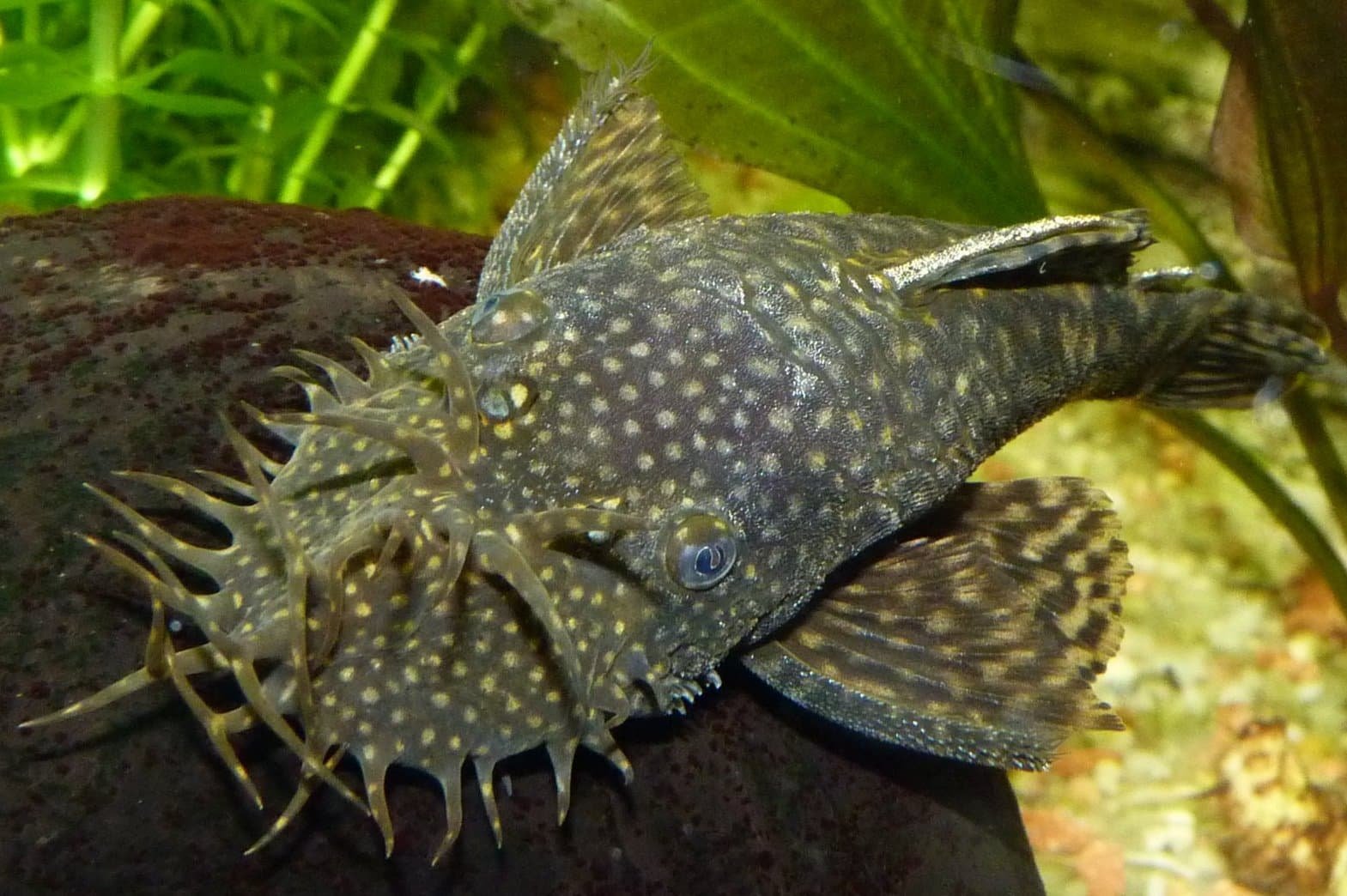The Baby Bristlenose Pleco, or juvenile Bristlenose Pleco, is a fascinating freshwater fish known for its unique appearance and easy care. Whether you’re a seasoned aquarist or a beginner, understanding the requirements and care for these young Plecos is crucial for their healthy development. This comprehensive guide will cover everything you need to know about Baby Bristlenose Plecos, including their natural habitat, care requirements, diet, and common issues.
Overview of Baby Bristlenose Plecos
Physical Characteristics
Baby Bristlenose Plecos are small versions of their adult counterparts, featuring the same distinctive traits, such as the bristle-covered head and robust body. However, their fins and bristles are not as pronounced as those in adults. The coloration of baby Plecos typically includes shades of brown, gray, or black with patterns of lighter spots or stripes, which can become more defined as they grow.
Natural Habitat
In the wild, Bristlenose Plecos, including babies, are native to the slow-moving rivers and streams of South America. Their natural habitat consists of a mix of rocky and sandy substrates with plenty of driftwood and aquatic plants. Mimicking these conditions in captivity is essential for their well-being and growth.
Behavior and Temperament
Baby Bristlenose Plecos are generally peaceful and relatively hardy. They are nocturnal by nature, meaning they are most active during the night and prefer to rest in shaded areas during the day. They may display territorial behavior as they grow, but they usually coexist well with other community fish, provided the tank has enough hiding spots.
Setting Up the Ideal Environment for Baby Bristlenose Plecos
Tank Size and Specifications
A minimum tank size of 20 gallons is recommended for a group of Baby Bristlenose Plecos. As they grow, they will need more space, so consider starting with a larger tank if you plan to keep them long-term or with other fish. Ensure the tank setup includes ample hiding spots and plenty of swimming space.
Water Parameters
Maintaining optimal water conditions is critical for the healthy growth of Baby Bristlenose Plecos. The ideal water parameters are:
- Temperature: 72-78°F (22-26°C)
- pH Level: 6.5-7.5
- Water Hardness: Soft to moderately hard (up to 10 dGH)
Regular water changes and a high-quality filtration system are necessary to keep the water clean and well-oxygenated. Consistent water parameters help prevent stress and promote healthy growth.
Substrate and Decor
A soft, sandy substrate is preferred for Baby Bristlenose Plecos, as it mimics their natural riverbed environment. Include plenty of hiding spots using rocks, caves, and driftwood. Driftwood is particularly important as it provides both shelter and a food source. Ensure that all decorations are securely placed to avoid shifting and potential injuries.
Lighting
Moderate to low lighting is ideal for Baby Bristlenose Plecos. As nocturnal creatures, bright lights can be stressful. Create shaded areas with plants or decorations to provide a more comfortable environment.
Diet and Feeding
Natural Diet
In their natural habitat, Baby Bristlenose Plecos feed on algae, detritus, and decaying plant matter. Their specialized teeth are adapted for scraping food from surfaces, including driftwood.
Feeding in Captivity
To replicate their natural diet, offer high-quality algae wafers and sinking pellets as staple foods. Ensure the tank contains ample driftwood for them to graze on, as it is an essential part of their diet. Supplement their diet with fresh vegetables such as zucchini, cucumber, and spinach. Occasionally, offer blanched peas and lettuce to diversify their nutrition.
Feeding Schedule
Feed Baby Bristlenose Plecos once or twice a day, preferably in the evening when they are more active. Monitor their food intake to avoid overfeeding and maintain water quality. Remove any uneaten food promptly to prevent water quality issues.
Growth and Development
Growth Rate
Baby Bristlenose Plecos grow relatively quickly compared to other fish species. They typically reach adulthood in about 6-12 months, depending on their environment and diet. Proper care, including a balanced diet and optimal tank conditions, is essential for healthy growth.
Signs of Healthy Development
Healthy Baby Bristlenose Plecos exhibit clear, vibrant coloration, active behavior, and consistent growth. They should have well-defined fins and bristles, and their body should appear robust and rounded. Regular monitoring and maintenance of tank conditions contribute to their overall health and development.
Breeding Baby Bristlenose Plecos
Breeding Conditions
Breeding Baby Bristlenose Plecos requires specific conditions and a bit of patience. Set up a separate breeding tank with optimal conditions, including soft, slightly acidic water and a temperature range of 76-80°F (24-27°C). Provide plenty of hiding spots, such as caves and driftwood.
Spawning Behavior
During the breeding season, males become more territorial and will guard a chosen cave or hiding spot. The female will lay her eggs in this location, and the male will fertilize them. The male then takes on the responsibility of guarding the eggs until they hatch, which typically takes about a week.
Raising the Fry
Once the eggs hatch, the fry can be fed infusoria or liquid fry food initially. As they grow, introduce finely crushed algae wafers and vegetables. Ensure the tank has plenty of driftwood, as the fry will start to graze on it early on.
Common Health Issues and Prevention
Common Diseases
Baby Bristlenose Plecos can be susceptible to common aquarium diseases if proper care is not taken. Some common issues include:
- Ich (White Spot Disease): Characterized by white spots on the body and fins, caused by a parasite. Treat with a suitable ich medication and slightly raise the water temperature to speed up the parasite’s life cycle.
- Fin Rot: Bacterial infection causing fins to appear ragged and frayed. Maintain excellent water quality and treat with antibacterial medication.
- Fungal Infections: Often appear as white or gray patches on the skin. Treat with antifungal medication and improve water quality.
Preventive Measures
Maintaining a clean and stable environment is the best way to prevent diseases. Regular water changes, proper filtration, and a balanced diet are crucial. Quarantine new fish before introducing them to the main tank to avoid introducing diseases.
Calico Bristlenose Pleco and Tank Mates
Compatible Tank Mates
Baby Bristlenose Plecos are generally peaceful and can coexist with other large, non-aggressive fish. Suitable tank mates include:
- Tetras
- Rasboras
- Gouramis
- Corydoras Catfish
- Other peaceful community fish
Avoiding Aggressive Species
Avoid housing Baby Bristlenose Plecos with aggressive or overly territorial fish. Species like large cichlids or aggressive barbs can stress or harm the Plecos. Ensure that all tank mates are compatible in terms of size and temperament.
Fun Facts About Baby Bristlenose Plecos
- Baby Bristlenose Plecos have a unique ability to digest wood due to specialized bacteria in their gut.
- Their distinctive bristles start to develop as they grow older, becoming more prominent in adults.
- They are known to produce a distinctive sucking noise when feeding on driftwood.
Conclusion
The Baby Bristlenose Pleco is a charming and resilient fish that can make a delightful addition to any aquarium. By understanding their natural habitat, dietary needs, and social behaviors, you can create a thriving environment that supports their growth and well-being. Whether you’re an experienced aquarist or just starting, the Baby Bristlenose Pleco offers both beauty and ease of care, making it an excellent choice for your aquatic setup.
FAQs
How big does a Baby Bristlenose Pleco get?
Baby Bristlenose Plecos typically grow to about 4-6 inches (10-15 cm) in length when fully grown.
What is the ideal tank size for Baby Bristlenose Plecos?
A minimum tank size of 20 gallons is recommended for a group of Baby Bristlenose Plecos. Larger tanks are preferable as they grow and if you plan to keep other fish.
What do Baby Bristlenose Plecos eat?
Baby Bristlenose Plecos primarily eat algae, detritus, and wood. In captivity, they should be fed high-quality algae wafers, sinking pellets, fresh vegetables (like zucchini, cucumber, and spinach), and have constant access to driftwood.
Can Baby Bristlenose Plecos live with other fish?
Yes, Baby Bristlenose Plecos are generally peaceful and can coexist with other non-aggressive fish such as tetras, rasboras, gouramis, and Corydoras catfish.
Do Baby Bristlenose Plecos need driftwood in their tank?
Yes, driftwood is essential for Baby Bristlenose Plecos as it forms a significant part of their diet and provides necessary nutrients for their digestion.
How long do Baby Bristlenose Plecos live?
With proper care, Baby Bristlenose Plecos can live for about 10-15 years in captivity.
What are the ideal water conditions for Baby Bristlenose Plecos?
The ideal water conditions for Baby Bristlenose Plecos are a temperature of 72-78°F (22-26°C), a pH level of 6.5-7.5, and soft to moderately hard water (up to 10 dGH).
How many Baby Bristlenose Plecos should be kept together?
Baby Bristlenose Plecos are territorial, so it is best to keep only one or a small group in a well-decorated tank with plenty of hiding spots.
What does a Baby Bristlenose Pleco eat?
Baby Bristlenose Plecos primarily eat algae, detritus, and wood. In captivity, they should be fed high-quality algae wafers, sinking pellets, fresh vegetables, and have constant access to driftwood.
Are Baby Bristlenose Plecos suitable for beginners?
Yes, Baby Bristlenose Plecos are suitable for beginners due to their relatively easy care requirements and hardy nature, provided the proper tank setup and maintenance are provided.
Discover more from EMMOCEB
Subscribe to get the latest posts sent to your email.






